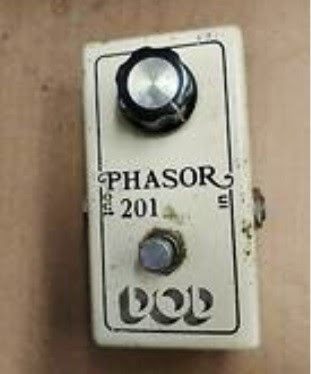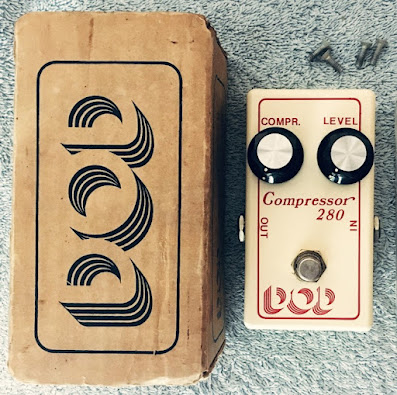As we like to do here at Tone Machines, today we're going to look into another pedal of mysterious origin. This is
The Fuzz, or as the internet has dubbed it,
Kurosawa The Fuzz. It's a 6 transistor monster, that for the most part, is a
Super Fuzz copy. All things point to an early 80s build, and definitely from Japan. But unfortunately that is where our solid(ish) information ends...
So today we're going to do as deep a dive as possible and grab from all of the currently existing info to see what we can come up with!
So first, the things we do know 100% from holding two of these in my hands:
A. They sound and act just like a Super Fuzz / FY-6.
B. The circuit board has "PRAT-7" and "Kurosawa" printed on it.
C. The circuit itself has 6 transistors and a single op-amp. Although the op-amp doesn't seem to do too much tone-wise.
D. The components are all consistent with other early/mid-80s Japanese builds.
E. The bottom plate has "Japan" embossed on it.
I was really hoping that some day an ad, or old magazine article, or even an actual box would pop up and we would get a clue to the brand behind
The Fuzz. But after a decade or so of scouring the net I came across nothing.
Until last year, when a friend of the blog reached out to show me that he had just purchased a beautiful boxed version!
Unfortunately it didn't help much to solve the mystery, but we did get to see the original price of ¥1980. And while it failed to have any sort of shop sticker, or date, it is really cool just to finally see a box! 😍
I have read/heard some rumors about who may be responsible for
The Fuzz. One of them was that the
Guyatone PS-030 Fuzz from the late 80s was essentially the same pedal, circuit and all. And that there may be a connection.
So I looked into this theory, and while the two do share similar sonic qualities (aka Super Fuzziness) the construction, the usage, and the components are just so different that I am going to have to rule this one out.
Awesome and underrated pedal though!
Next is the supposed connection that some people swear is the smoking gun.
"What about that enclosure??? It sure looks a lot like the
Locobox pedals from the same time period, from Japan. And they're known for licensing to OEM brands. CASE CLOSED!!!"
Ok, so let's look into Locobox and see what other similarities we can find, if any.
As you can see, the enclosures for both pedals are actually the same! I can't deny that. Same size, same little slant on the front, same rounded corners, everything.
Now I do fancy myself a bit of a pedal detective (lol) and this was something I noticed around 2009 when I first became aware of the Kurosawa fuzz.
And if we just take the enclosure, it does seem to be a pretty enticing conclusion. But if you keep looking, even at just the outside of the pedal, lots of small differences start to emerge.
So let's take a look at this
Electra Compressor, which was built by Locobox and shares the same circuit as their legendary "
The Choker" pedal.
Locobox built pedals for a ton of other brands like Rolling, Nadines, Boston, Volz, and more. All of them use the exact same circuits, placement of jacks and pots, and wiring. The only variation I have found is the bottom plate and a couple of them use different knobs.
So if we know that for the most part, all of the OEM Locobox pedals are built the same, then we quickly begin to see some differences with the Kurosawa.
Take the input/output jacks. Every one of the Locobox pedals has the jacks below the slant of the enclosure. While the Kurosawa clearly has them above.
Now while I didn't take a photo to compare, you're just gonna have to trust me on this one, but the 9v jack is on the top right of each Locobox pedal and is a completely different type; while the Kurosawa's 9v jack is on the top left.
The bottom plates do not match up either. There are 3 variations in the Locobox builds, but none of them use the plastic, battery holder snapout like the Kurosawa does.
I will give you a couple of similarities though; the LED and the footswitch placement are the same. But those both seem to be pretty logical spots given the enclosure, and could have even been pre-drilled?
Ok so the outside seemed to fail the test, but what about the inside. Surely that's the clincher...
So here are two Locobox pedals opened up. The boards are consistent with every other variation/OEM; all showing a serial number on the bottom right and the wiring connections to the left.
Notice that the serial numbering system is completely different (compared to "PRAT-7" we just get a string of numbers followed by a single letter). But also there is nothing printed on the board that mentions not only Kirosawa, but no brand name at all.
And finally, if you look back at The Fuzz board above, you'll notice the wiring connections are located at the bottom, not to the left.
The most convincing argument though has to be that Locobox never released their own Fuzz pedal.
Even if we look into the connection with
Aria (who were the distributers for Locobox, and even co-promoted them as a part of their own brand), we don't see a fuzz pedal that would have been out at the same time. The
mid-70s Aria fuzzes are completely different inside, and the
late 80s Aria fuzz, in its plastic enclosure, is also a totally different animal than any of the Locobox pedals or the Kurosawa fuzz.
So what can we take from all of this?
I think the most simple answer is, The Fuzz and Locobox purchased their enclosures from the same place.
That's it. No other connection there!
And I bet if we dig a little deeper we can find even more pedals from this era that also used the same enclosure. I honestly haven't looked at all, but I would put money on it.
I definitely did not mean to make this a post about the history of Locobox, but hey, it happens.
Well, what do I think is the actual origin of the Kurosawa fuzz? If I really had to guess, my assumptions would point me in the direction of the Kurosawa Musical Instruments shop in Japan. This has been one of the largest and longest running guitar stores in the country and it would make sense that they not only had an in-house fuzz pedal, but that they could simply call it The Fuzz because the brand IS them.
Sadly we still do not know for sure who built these, or really anything more than when we started. But hopefully this post helps to pull some new facts out of the dust, and we can an update it at some point in the near future.
As always if you happen to have additional info, agree or disagree with anything I've posted here, please message me via
Email /
Instagram.
Thanks for reading!
-ed






















